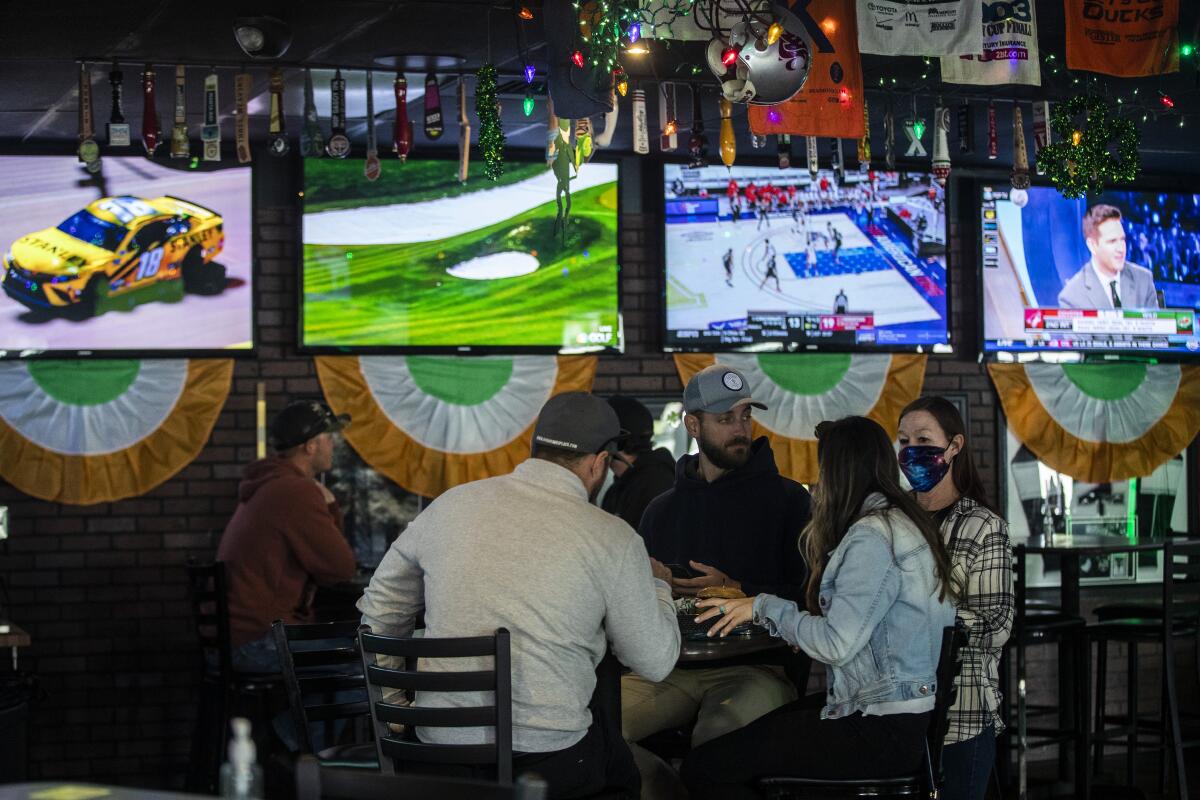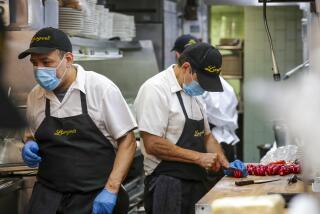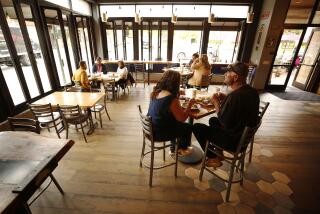Some Southern California restaurants reopen indoor operations Sunday to crowds, questions

The first day of indoor dining was quiet at Tudor House, a historic dinner theater in Lake Arrowhead. Pre-pandemic, the Prohibition-era restaurant would seat 60 people at once for its champagne brunch. By 11 a.m. Sunday, there were just two.
“It’s not a matter of when the government says you can open, it’s when people reestablish that routine,” said owner John Connor. “It’ll be a slow process for people to get their big-boy pants on.”
San Bernardino and Orange counties on Sunday exited the purple tier, the most restrictive of California’s color-coded reopening blueprint, clearing the way for restaurants to resume indoor dining at 25% capacity. Los Angeles County will join them Monday in permitting additional reopenings.
Some businesses reported a quick rebound.
Virginia Ramirez, a hostess at Belgian Waffle Works in Lake Arrowhead, said the dining room of the popular family restaurant was slammed Sunday morning. “We’re really busy,” she said.
At Social Costa Mesa, a trendy New American eatery, patrons were eager to dine indoors, said Robert Garcia, the manager on duty.
“Business is solid right now,” he said over the clink of tableware and chatter of customers. “I can’t complain. We’re lucky to have what we have going on.”
But other establishments said customers were slower to return.
“Right now, 90% of the public doesn’t even know we’re open,” Connor said. He said heavy snowfall made heated tents impractical for restaurants in the mountain resort town and unattractive to the area. But he had high hopes for April, when he planned to host a mystery theater show.
“The L.A. mob used to own the Tudor House, so we might do a Bugsy Siegel, gangster kind of a theme,” he said.
Still, he worried the government could once again reverse course.
“Restaurants can’t be yo-yoed like that: hire staff, let them go, buy food, throw it out,” Connor said. “Another shutdown is a good possibility, and 25% doesn’t make any profit — but eventually you’ve got to pay for the rent.”
Los Angeles, Orange and San Bernardino counties joined 10 others — Contra Costa, Sonoma, Placer, Mendocino, San Benito, Tuolumne, Siskiyou, Amador, Colusa and Mono — in moving to the less restrictive red reopening tier. The 13 counties are home to 17.7 million Californians, meaning that by Monday when L.A. County gives the green light, about 45% of the state’s population will be able to eat inside a restaurant, visit a museum or take a yoga class indoors.
In addition to offering indoor dining, counties in the red tier are permitted to resume showings at movie theaters at 25% capacity, welcome students in seventh through 12th grades back to campuses, reopen indoor gyms at 10% capacity, and expand capacity restrictions at nonessential stores and libraries. Museums, zoos and aquariums also can reopen indoor operations, at 25% capacity.
“I think it’s a long time coming,” Orange County Supervisor Don Wagner said Sunday. “It’s a great step in the right direction. The governor probably could have done it sooner, but at this point I’ll take the step in the right direction.”
He said he’s heard an “enormous amount” from constituents about economic hardship caused by the virus and the subsequent rules, as well as physical, mental and emotional stress.
But he’s recently seen that change to tentative hope.
“The people I’ve talked to over the course of the last couple days, knowing that the red tier is coming and we’re able to do much more, just seem to have more of a bounce in their step,” he said. “I think there’s a genuine optimism out there nowadays that the worst days of the pandemic are behind us.”
Still, some businesses said that despite the relaxation, a more comprehensive reopening wasn’t yet worth their while.
Heidi Grunt owns the 29 Palms Inn outside Joshua Tree National Park. The park was bustling with tourists for the spring bloom, and by 10 a.m. Sunday, her phone was ringing off the hook with hungry hopefuls inquiring about indoor dining.
“This morning, I’ve had at least five phone calls: ‘Word’s out that it’s supposed to be OK’ and ‘Why aren’t you doing it?’” she said. “But if you can only open at 25%, it’s still very challenging to operate like that. It still requires a lot of staff, and you still can’t do the business that you once did.”
Before the crisis, the hotel and restaurant employed about 65 people. Now, Grunt said, they’re down to 10.
“We’ve thought of ourselves more in a resort sense since COVID,” she said. “We’ve continued to provide some meals to our hotel guests but not necessarily to the public.”
As some businesses worked on further reopening, others were in waiting mode, at least for a couple of weeks.
Amusement parks can reopen at 15% capacity, with other modifications, starting April 1. Attractions such as Disneyland, Universal Studios, Knott’s Berry Farm and Six Flags Magic Mountain, some of which have reopened for limited food and shopping events, will initially be required to limit visitors to California residents. Outdoor sports — with fans — and outdoor live performances also will be allowed to resume April 1, provided they adhere to restrictions on capacity and concession sales that vary by tier.
L.A. County health officials — along with the health departments of the cities of Long Beach and Pasadena — said permission for red-level reopenings would take effect at 12:01 a.m. Monday.
L.A. County Health Officer Dr. Muntu Davis said the decision to wait until Monday was “really to give businesses some time” to prepare and appropriately modify their operations.
Another 13 counties — San Diego, Riverside, Sacramento, Ventura, San Joaquin, Tulare, Santa Barbara, Monterey, Kings, Sutter, Yuba, Lake and Tehama — are poised to join the red tier as soon as Wednesday, provided their coronavirus metrics remain steady.
“It’s nice to see hope on the horizon and a sense of normalcy coming back into place,” Orange County Supervisor Lisa Bartlett said Sunday.
She said that while it’s great to be able to start to reopen the local economy, she’s even more excited about what the step forward signifies.
“Moving into the red tier is a key signal that we are hopefully getting the upper hand on COVID-19,” she said. “Hospitalizations are down. ICU bed rates are down. More people are getting vaccinated — thousands of people every single day in our county.”
That doesn’t mean the virus has gone away, she noted: It will take time to vaccinate all 3.2 million Orange County residents, and more transmissible, potentially deadlier variants continue to circulate. Measures such as masking, hand-washing and distancing remain crucial.
“It’s really important even after someone is vaccinated to continue to adhere to health and safety guidelines to further protect themselves and those around them,” she said. “Those are still all important things to continue to keep in mind and adhere to as we continue to move through getting out of the COVID pandemic.”
Times staff writers Luke Money and Rong-Gong Lin II contributed to this report.
More to Read
Sign up for Essential California
The most important California stories and recommendations in your inbox every morning.
You may occasionally receive promotional content from the Los Angeles Times.








